Many U.S. children have experienced bullying, whether online or in person. This has prompted discussions about schools’ responsibility to curb student harassment, and some parents have turned to home-schooling or other measures to prevent bullying.
Here is a snapshot of what we know about U.S. kids’ experiences with bullying, taken from Pew Research Center surveys and federal data sources.
Pew Research Center conducted this analysis to understand U.S. children’s experiences with bullying, both online and in person. Findings are based on surveys conducted by the Center, as well as data from the Bureau of Justice Statistics, the National Center for Education Statistics and the Centers for Disease Control and Prevention. Additional information about each survey and its methodology can be found in the links in the text of this analysis.
Bullying is among parents’ top concerns for their children, according to a fall 2022 Center survey of parents with children under 18. About a third (35%) of U.S. parents with children younger than 18 say they are extremely or very worried that their children might be bullied at some point. Another 39% are somewhat worried about this.
Of the eight concerns asked about in the survey, only one ranked higher for parents than bullying: Four-in-ten parents are extremely or very worried about their children struggling with anxiety or depression.
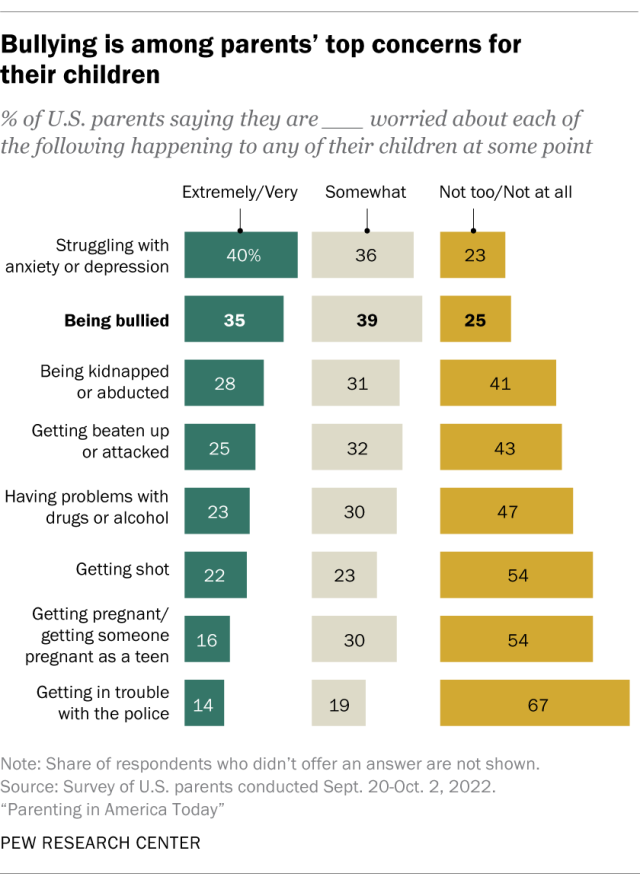
About half of U.S. teens (53%) say online harassment and online bullying are a major problem for people their age, according to a spring 2022 Center survey of teens ages 13 to 17. Another 40% say it is a minor problem, and just 6% say it is not a problem.
Black and Hispanic teens, those from lower-income households and teen girls are more likely than those in other groups to view online harassment as a major problem.
Nearly half of U.S. teens have ever been cyberbullied, according the 2022 Center survey of teens. The survey asked teens whether they had ever experienced six types of cyberbullying. Overall, 46% say they have ever encountered at least one of these behaviors, while 28% have experienced multiple types.
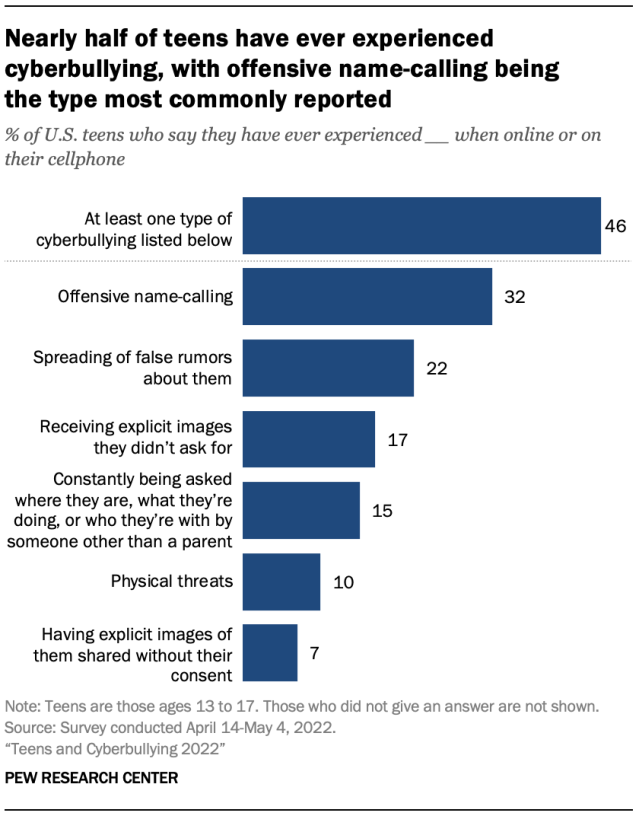
The most common type of online bullying for teens in this age group is being called an offensive name (32% have experienced this). Roughly one-in-five teens have had false rumors spread about them online (22%) or were sent explicit images they didn’t ask for (17%).
Teens also report they have experienced someone other than a parent constantly asking them where they are, what they’re doing or who they’re with (15%); being physically threatened (10%); or having explicit images of them shared without their consent (7%).
Older teen girls are especially likely to have experienced bullying online, the spring 2022 survey of teens shows. Some 54% of girls ages 15 to 17 have experienced at least one cyberbullying behavior asked about in the survey, compared with 44% of boys in the same age group and 41% of younger teens. In particular, older teen girls are more likely than the other groups to say they have been the target of false rumors and constant monitoring by someone other than a parent.
They are also more likely to think they have been harassed online because of their physical appearance: 21% of girls ages 15 to 17 say this, compared with about one-in-ten younger teen girls and teen boys.
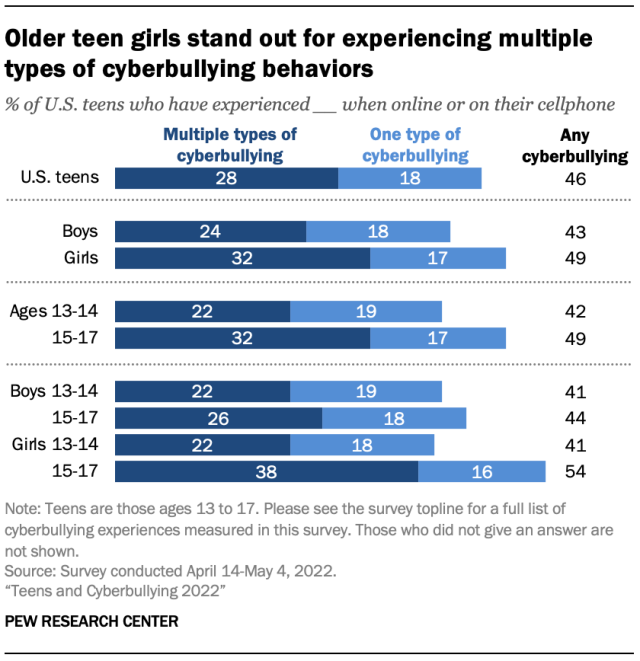
White, Black and Hispanic teens have all encountered online bullying at some point, but some of their experiences differ, the spring 2022 teens survey found. For instance, 21% of Black teens say they’ve been targeted online because of their race or ethnicity, compared with 11% of Hispanic teens and 4% of White teens.
Hispanic teens are the most likely to say they’ve been constantly asked where they are, what they’re doing or who they’re with by someone other than a parent. And White teens are more likely than Black teens to say they’ve been targeted by false rumors.
The sample size for Asian American teens was not large enough to analyze separately.
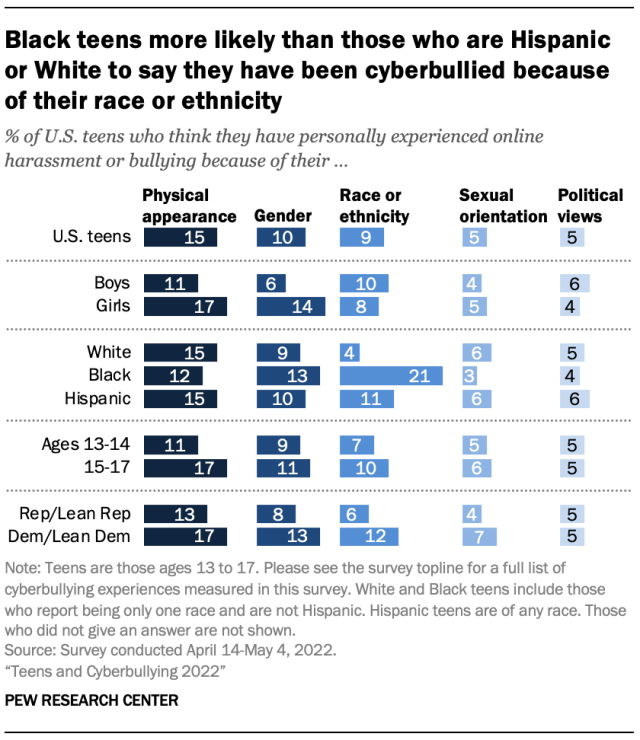
During the 2019-2020 school year, around two-in-ten U.S. middle and high school students said they were bullied at school. That year, 22% of students ages 12 to 18 said this, with the largest shares saying the bullying occurred for one day only (32%) or for between three and 10 days (29%), according to the most recent available data from the Bureau of Justice Statistics (BJS) and the National Center for Education Statistics (NCES).
Certain groups of students were more likely to experience bullying at school. They include girls, middle schoolers (those in sixth, seventh or eighth grade), and students in rural areas.
The most common types of at-school bullying for all students ages 12 to 18 were being made the subject of rumors (15%) and being made fun of, called names or insulted (14%).
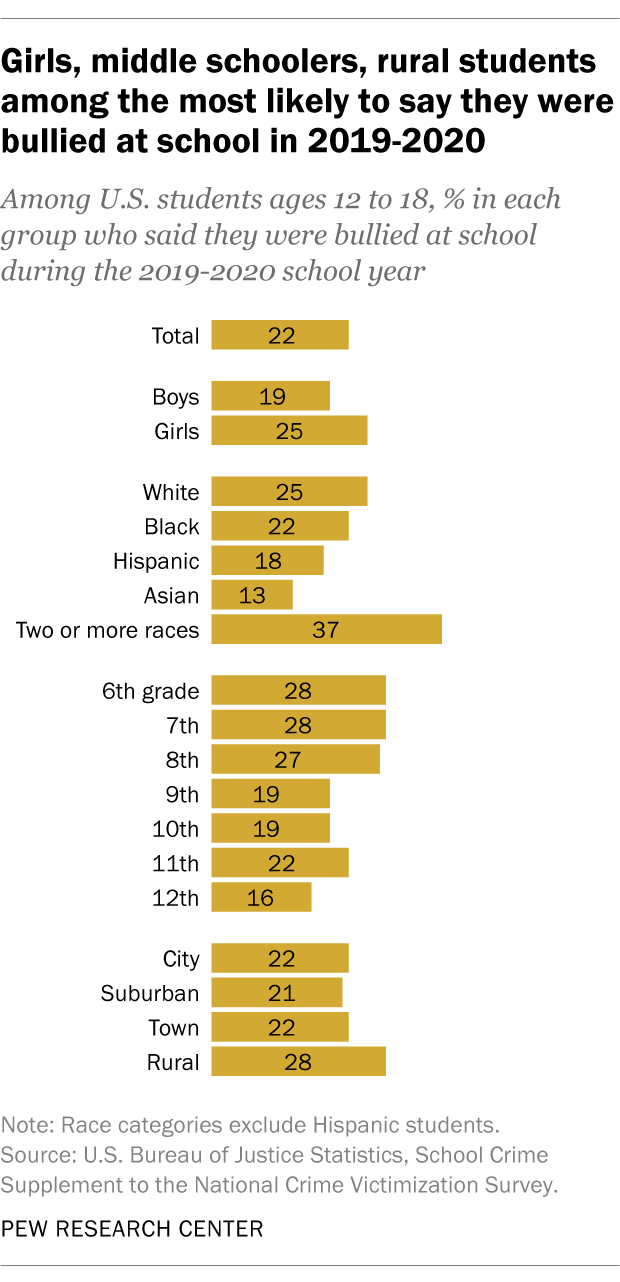
The classroom was the most common location of bullying that occurred at school in 2019-2020, the BJS and NCES data shows. This was the case for 47% of students ages 12 to 18 who said they were bullied during that school year. Other frequently reported locations included hallways or stairwells (39%), the cafeteria (26%) and outside on school grounds (20%).
Fewer than half (46%) of middle and high schoolers who were bullied at school in 2019-2020 said they notified a teacher or another adult about it, according to the BJS and NCES data. Younger students were more likely to tell an adult at school. Around half or more of sixth, seventh and eighth graders said they did so, compared with 28% of 12th graders.
Students who reported more frequent bullying were also more likely to notify an adult at school. For instance, 60% of those who experienced bullying on more than 10 days during the school year told an adult, compared with 35% of those who experienced it on one day.
In 2021, high schoolers who are gay, lesbian or bisexual were about twice as likely as their heterosexual counterparts to say they’d been bullied, both at school and online, according to the Centers for Disease Control and Prevention. In the 12 months before the survey, 22% of high school students who identify as gay, lesbian or bisexual – and 21% of those who identify as questioning or some other way – said they were bullied on school property. That compares with 10% of heterosexual students. The data does not include findings for transgender students.
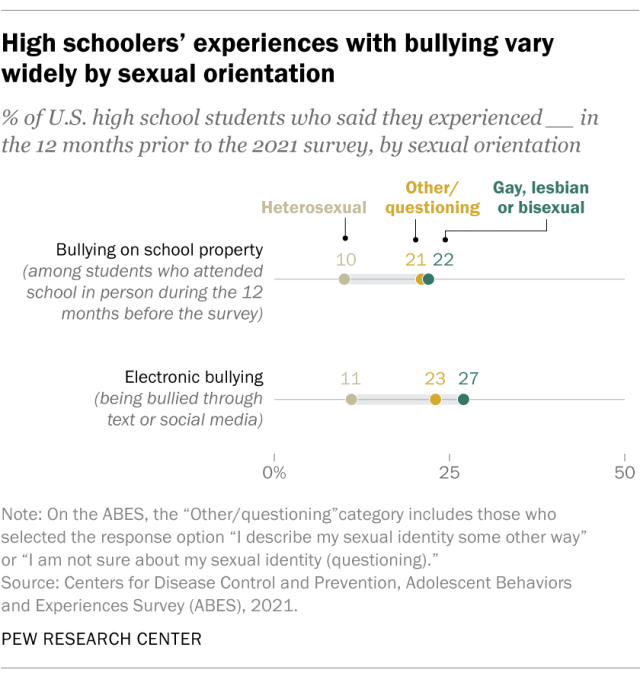
The trend is similar when it comes to electronic bullying through text or social media: 27% of high school students who identify as lesbian, gay or bisexual say they experienced this in the 12 months before the survey, as did 23% of those who identify as questioning or some other way. That compares with 11% of those who identify as heterosexual.
